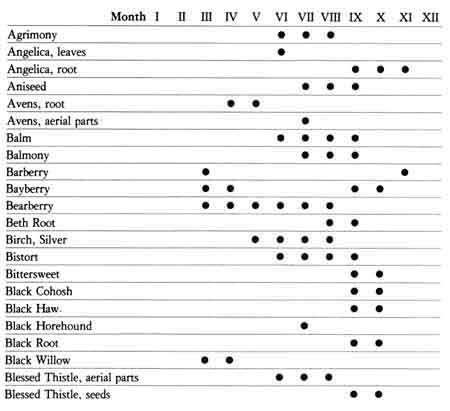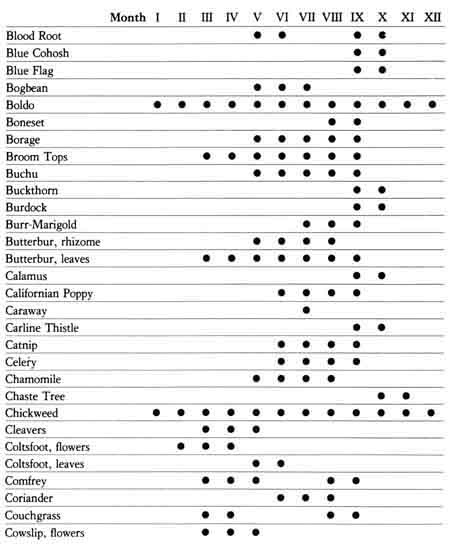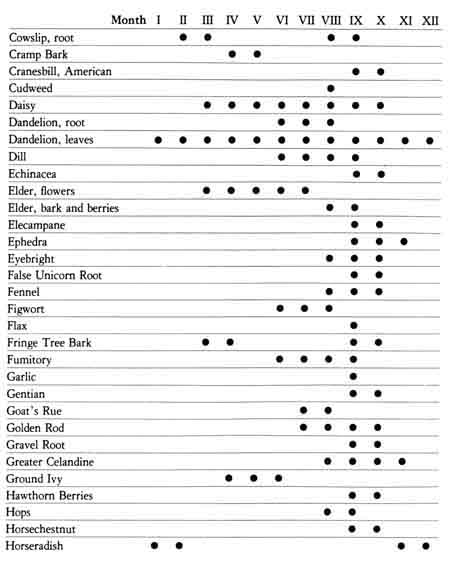Gathering Herbs

The gathering of herbs is a delightful task. Whether harvesting a cultivated crop or searching out the plants in the wild, it is an opportunity to lovingly acknowledge and celebrate the abundance and wholeness of our planet. There are many details about times and processes of collecting and drying, but the heart of the matter is the consciousness that is brought to it by the collector. Collection can be a meditation, a ritual affirmation of our role as co-creators with nature.
Much research has gone into the effects of growth cycle, daily rhythms and climate on the biochemical composition of medicinal plants. What this work shows us is that the old lore about the right times to pick each plant has a solid basis in plant chemistry. The active components are found at different levels at different times of the day, of the month and of the growth cycle. However, some broad generalisations can usefully be made.
The level of active constituents is highest at the end of the period of most active growth. The plants should thus be gathered just before opening into blossom. A day without rain which has been sunny since daybreak is ideal for collecting. Though some leaves may dry quickly after rain, others like the thick, furry ones of Horehound retain the moisture, and if allowed to be massed before drying may easily develop mould and become spoilt. Too much heat dries up the oil in the leaves. Only the best shaped, greenest leaves should be gathered, and any that are withered, insect bitten or stained should be discarded. This applies also when the whole plant is gathered, for the leaves nearest the root may be imperfect.
Leaves and herbs should be cut with a sharp knife or secateurs, for pulling them off by hand may easily damage the tender stems of plants, causing delay in new growth or the entry of fungus or insects into the damaged tissue.
Though many herbs grow along roadsides and in waste soil, pick only from those places free of excessive traffic. Also be sure to avoid fields sprayed with chemicals, as these will dry and infuse right along with your medicinal herb. Investigate fields, woodlands and hedges surrounding organic farms, with the owner’s permission, if unpolluted sources are otherwise rare in your area.
Drying herbs
Herbs should be dried by spreading them in loose, single layers on flat drying surfaces. Wire cooling racks from the kitchen may be especially useful surfaces, since these allow air circulation underneath and hence quicker drying. Time for drying depends on the herb and the environment, so check the herbs often and turn them as needed for even drying.
Drying roots
Roots are perhaps the most difficult part of herbs to dry, especially as they are usually very damp when dug up, since digging takes place in the autumn when the soil is likely to be muddy and sticky. Roots must not be dug for medicine while the leaves are still in full growth, as they have not achieved their maximum medicinal content, some of this still being retained in the part of the plant above ground.
When lifting, an effort must be made to get out the entire root, so a long spade or fork is needed. The root will come up with soil and mud adhering to it. A good deal of this can be scraped off, but the only efficient way to clean roots is by thorough washing. Scrubbing is usually necessary too. Top stems and rootlets should then be cut off and large roots, such as those of Liquorice and Burdock, may be sliced to hasten drying.
To dry, they should be spread out on shelves so they do not touch or should be tied singly on strings in a warm shed or greenhouse for about ten days, being turned and inspected every day. When they have started to shrink well (roots loose about ¾ of their weight in drying) they can be finished by storing them above a stove or in a cool oven. This will probably take another ten days and is dependent on the moisture in the atmosphere. Roots are dry when they are brittle.
To dry bulbs and corms, tie them up in small bunches, like onions, in a shed. Keep constant watch to see that they are drying evenly.
Storing herbs
As soon as it is dried, the herb, whether root or aerial part, should be placed immediately into a dry container. The material should be handled with great care as it may be readily broken. Any herb which contains volatile oils should not be stored in ordinary plastic boxes or sacks, for these materials absorb the oils from the plant which then evaporate from the external surface. Glazed ceramic, dark glass or metal containers with tight-fitting lids are best for storage, away from direct sunlight or heat.
When to gather herbs
In every season nature offers herbs, but naturally not everything is available at all times. To find out in which month a herb can be collected, refer to the calendar. It lists most of the herbs mentioned, with the exception of those that cannot usually be found in Europe. When different parts of a herb are collected at different times, they are listed separately. The dates given refer to Middle and Northern Europe.





